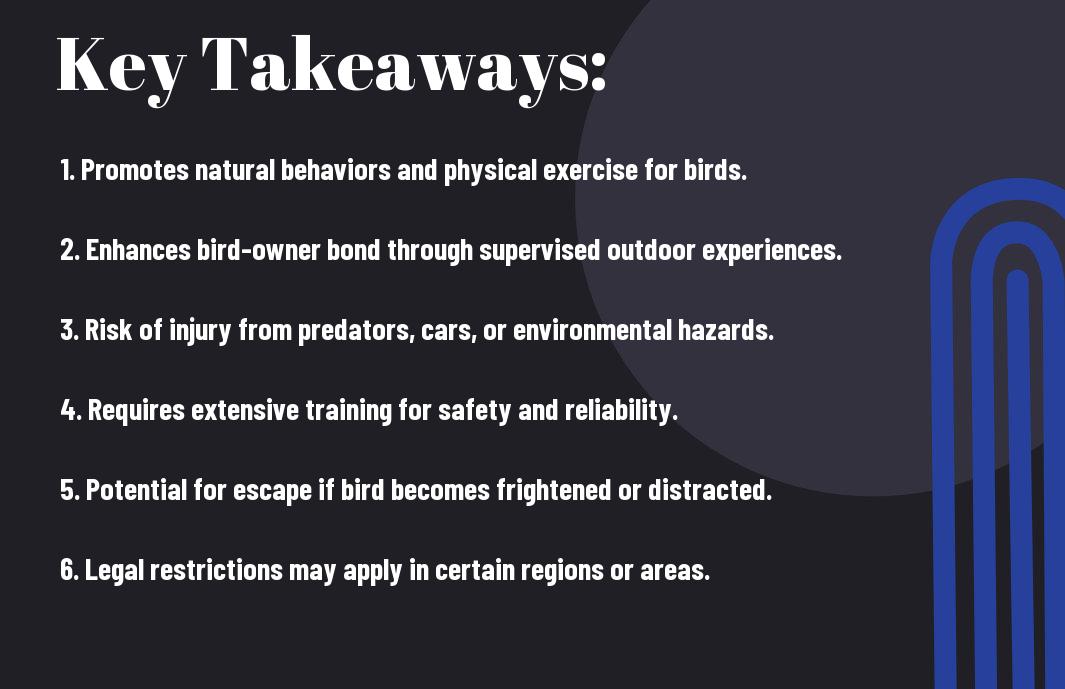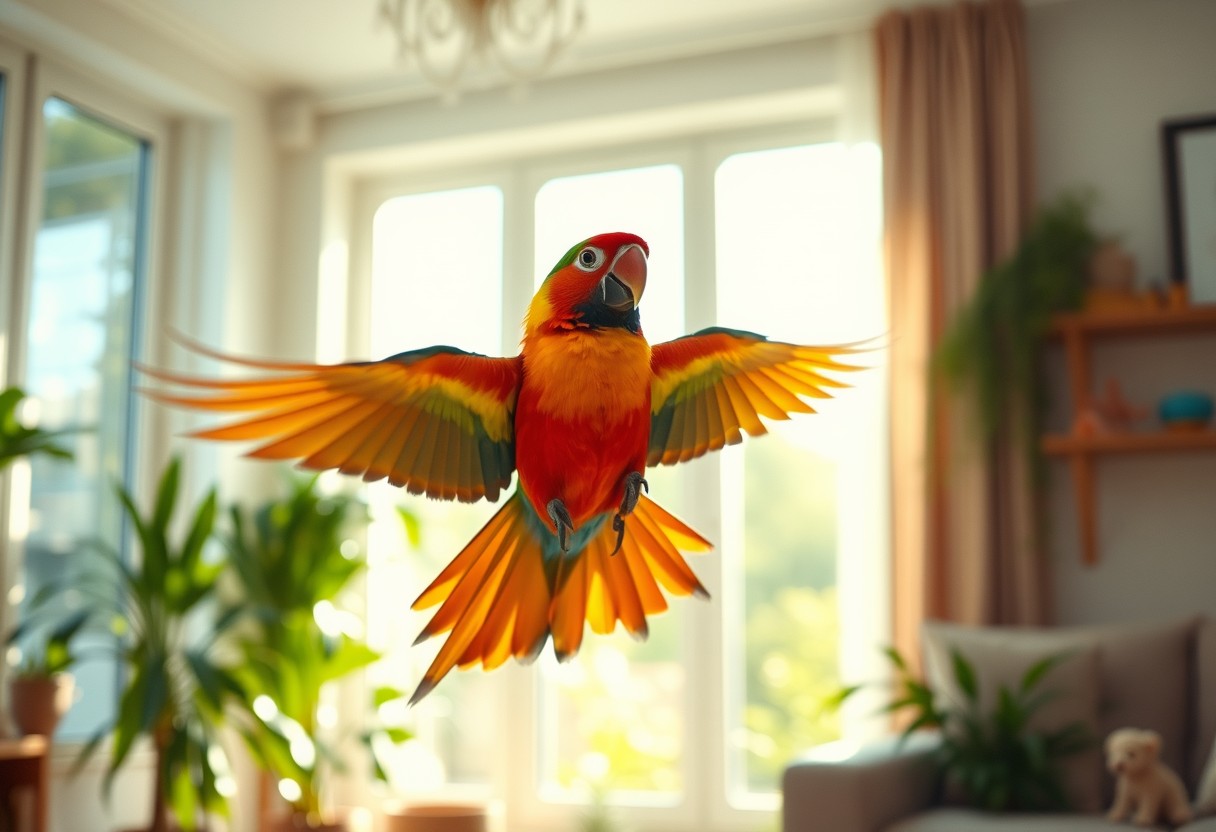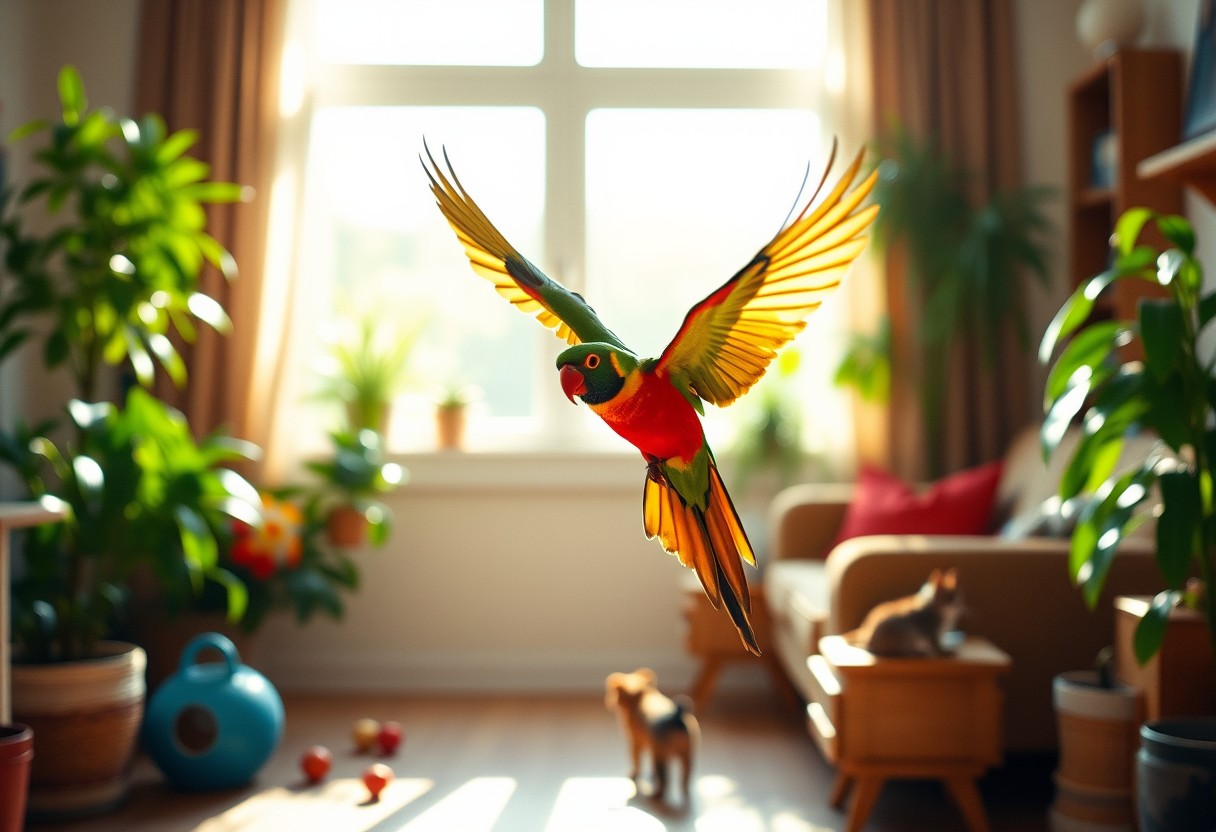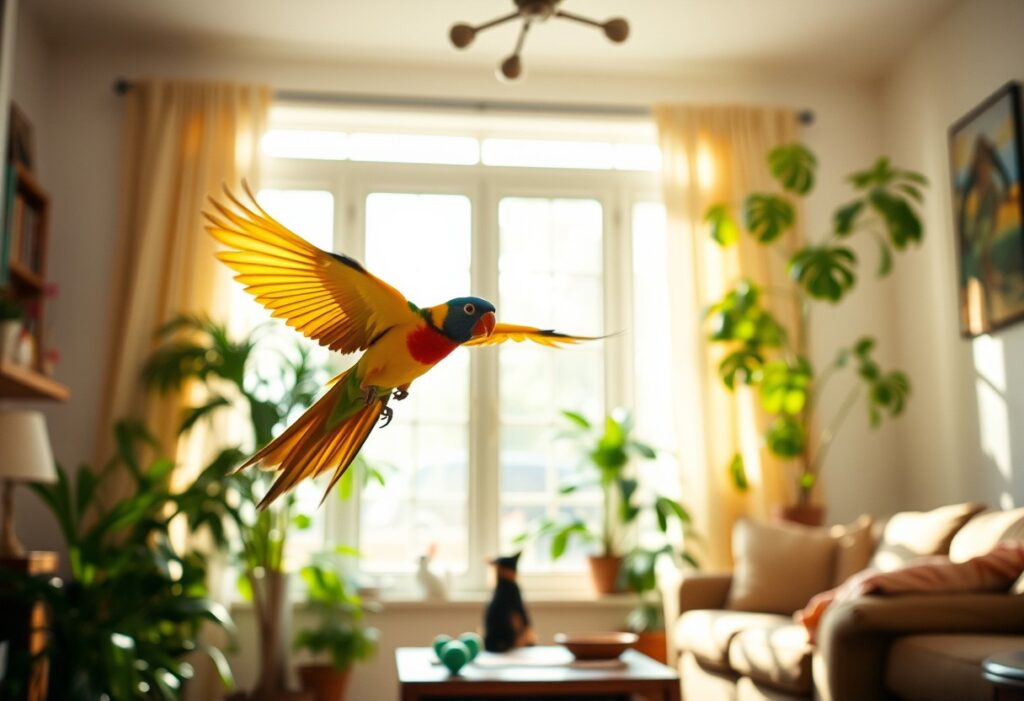Cons of free-flying your pet bird include potential dangers such as predators, traffic hazards, and the risk of losing your bird in unfamiliar environments. However, there are also undeniable benefits, including increased exercise, mental stimulation, and a chance to develop a stronger bond with your feathered friend. Before deciding whether to let your bird soar freely, it’s crucial to consider both the alluring joys and the significant risks associated with this practice. In this post, we’ll probe into the vital pros and cons of free-flying your pet bird.


Benefits of Free-Flying Pet Birds
Physical Health Benefits
Your pet bird, whether a parakeet, cockatiel, or larger species, can greatly benefit from the physical health advantages of free-flying. With ample opportunities to exercise, your bird can engage in natural flight patterns that promote overall fitness. This physical activity can help prevent obesity, which is a prevalent issue among pet birds kept in confined spaces. A well-exercised bird tends to have stronger muscles, improved cardiovascular health, and more robust feathers, contributing to their overall vitality.
With regular free-flying sessions, you will likely notice an improvement in your bird’s coordination and agility. Birds that fly freely develop better balance and reflexes, which can help prevent accidental injuries. Engaging in consistent physical activity through free-flying not only contributes positively to your bird’s health but also offers long-lasting benefits that can enhance their quality of life.
Mental Stimulation and Enrichment
Mental stimulation is just as crucial as physical activity for your pet bird. Mental challenges created during free-flying provide opportunities for your bird to develop their problem-solving skills and engage their natural instincts. You can create obstacle courses or use treats to encourage exploration and maneuvering, enabling your bird to stay sharp and aware as they navigate their environment.
Benefits of free-flying encompass a range of mental enrichment activities that can help stave off boredom and associated behavioral problems. Birds that frequently fly tend to exhibit less stress, anxiety, and aggression, as these activities allow them to channel their natural energy healthily. By keeping your feathered friend engaged, you contribute to their happiness and long-term well-being.
Strengthening Human-Bird Bond
To deepen your connection with your pet bird, free-flying acts as a unique opportunity for interaction. Allowing your bird to fly under your supervision creates shared experiences that foster trust and companionship. As you engage in training sessions and reunions post-flight, your bond will strengthen. Birds often become more attached and loyal to their owners through these shared moments, leading to a more fulfilling relationship.
The benefits of free-flying also extend to your bird’s perception of you as a leader and companion. Animals naturally gravitate towards social structures, and when you provide positive reinforcement during free-flying sessions, it cultivates respect and love. Whether through guided exercises or casual play, these experiences will enrich your relationship with your feathered friend.
Natural Behavior Expression
Stimulation through free-flying enables your pet bird to express their natural behaviors more freely, which is necessary for their overall well-being. When they can fly, your bird can exhibit traits like preening, foraging, or even socializing with you in ways that are not possible when they are constantly confined. These expressions of their innate behaviors help create a stress-free environment where your bird can thrive.
Physical engagement linked to free-flying not only encourages better muscle development but also promotes necessary social interactions. Birds in the wild are not only flyers but also foragers, and allowing them to explore your home encourages the same instincts. By catering to these natural tendencies, you create a happier and healthier environment for your avian companion.
Potential Risks of Free-Flying
The potential risks associated with free-flying your pet bird cannot be overlooked. While the idea of allowing your feathered friend to soar through the sky may evoke images of freedom and happiness, it also comes with significant dangers that demand your attention. Understanding these risks is vital to ensure your pet’s safety and well-being.
Environmental Hazards
Potential environmental hazards are one of the primary considerations when free-flying your bird. Urban areas can present a multitude of dangers, including traffic, pollution, and other human-made obstacles that your bird might not be able to navigate effectively. Even natural environments can pose risks such as adverse weather conditions, from sudden storms to high winds, which can disorient your bird and lead to serious consequences.
Additionally, while the outdoors may seem like a vast playground for your bird, you must remain vigilant about potential toxins in the air and chemical pollutants present in the environment. These factors can negatively impact your bird’s health, and the risk only increases the longer your bird is exposed to the outside world.
Escape and Loss
An unfortunate reality that comes with free-flying your pet bird is the potential for escape and loss. Birds are inherently adventurous creatures, and no matter how much you train them or how closely you supervise them, there is always the chance they may fly away. This risk becomes exponentially higher in unfamiliar settings, where new sounds, sights, and distractions may lure your bird beyond your reach.
With every moment your bird is outside, the risk of loss increases, especially if they encounter a potential escape route. Whether that’s a sudden gust of wind or an unforeseen distraction that catches their attention, no precaution can fully eliminate the chance of your bird escaping from your sight.
Predation Threats
Environmental conditions are not the only threats your bird may face; there are serious predation threats to consider as well. In the wild, birds are preyed on by a variety of animals, including hawks, cats, and even larger birds. When you allow your pet bird to free-fly, you are inadvertently exposing them to these natural predators that could quickly make your beloved pet their next meal.
It is necessary to recognize that even if your bird is trained and aware of its surroundings, a predatory animal can strike at any moment, leaving little time for you to react. Understanding the local wildlife in your area and determining the level of risk can help you make informed decisions about whether free-flying is right for your bird.
Health Risks and Illness
Free-flying your pet bird also introduces various health risks and illnesses that can be detrimental to their well-being. When your bird is exposed to the outside environment, they can come into contact with numerous pathogens and parasites that they might not encounter indoors, increasing their vulnerability to various diseases. This exposure could lead to respiratory infections, parasitic infestations, and even serious illness that may require veterinary intervention.
Another factor to keep in mind is that free-flying increases the likelihood of injuries from falls, collisions, or other accidents, which can result in broken bones or cuts. Ensuring your bird remains healthy while enjoying their free-flying experience necessitates increased caution and vigilance to minimize these risks.

Considerations Before Free-Flying
Unlike traditional pet ownership, free-flying your pet bird involves a range of factors that you need to carefully consider. While the idea of letting your bird soar through the skies can be exhilarating, it’s important for you to assess whether both you and your feathered friend are ready for the responsibility and risks involved.
Ideal Bird Species for Free-Flying
Ideal candidates for free-flying are typically small to medium-sized bird species that exhibit strong flying abilities and a well-developed bond with their owners. Species such as parrots, finches, and canaries are often more receptive to training and environmental interactions. For instance, **African Greys** and **Cockatiels** are known not only for their intelligence but also for their loyalty. Their propensity to engage positively with humans makes them suitable for this experience.
However, it is crucial to consider the temperament and personality of your specific bird. Some species are more skittish and prone to stress when faced with open environments, while others thrive in such conditions. Thus, you’ll want to ensure your bird is calm, sociable, and accustomed to a variety of stimuli before attempting to free-fly.
Training and Preparation
For successful free-flying, rigorous training and preparation are paramount. This involves introducing your bird to outdoor environments gradually, acclimatizing them to the vastness of open spaces, and reinforcing their training through positive reinforcement methods. You should spend ample time in controlled settings where your bird can practice their flying skills while also building their confidence.
A successful training regimen typically includes recall training, where you teach your bird to return to you on command. This step is critical in ensuring their safety during free-flying sessions. The initial stages should be conducted in a secure area, using rewards like treats to motivate your bird. Gradual exposure to varied outdoor elements will also help your pet acclimate and feel comfortable in different settings, thus reducing the likelihood of panic or erratic flying behavior.
Safe Environments for Free-Flying
Free-flying can be a magnificent experience for you and your bird, but it must be done in a safe and controlled environment. Ideally, you should seek out areas that are free of potential hazards, such as heavy traffic, other aggressive birds, or unmonitored predators. Designated parks or enclosed backyards can provide your bird with ample space to explore while keeping them away from harmful situations.
Species-specific needs should also be taken into account when selecting free-flying locations. Some birds might require specific conditions, such as temperature or humidity levels, which you must ensure are met. Environmental factors play a significant role in determining not only your bird’s comfort level but also their overall safety during outdoor excursions.
Legal and Ethical Considerations
Free-flying birds also raise important legal and ethical considerations that require careful thought. You need to be aware of local regulations regarding keeping and flying birds outdoors. In some areas, there are laws that categorize certain bird species as “wild” or “endangered,” making it illegal for you to release them into the wild. It’s your responsibility to understand and comply with these laws to avoid potential penalties.
Additionally, ethical concerns come into play regarding the wellbeing of your bird. Free-flying should never come at the expense of your bird’s mental and physical health. Taking the time to understand the *long-term implications* of free-flying when your bird is unprepared or poorly trained can prevent negative outcomes for both you and your pet.
It is imperative for you to research and weigh all legal and ethical factors before deciding to free-fly your pet bird, as this will shape both your experience and your bird’s wellbeing.
Conclusion
Following this detailed exploration of the pros and cons of free-flying your pet bird, it’s imperative for you to weigh the potential benefits against the risks involved. On one hand, you can enjoy the profound bond and trust that develops between you and your bird, alongside the physical and mental stimulation that free-flying provides. This practice can also enhance your bird’s natural abilities and behaviors, contributing to a more fulfilling and enriching life. However, you must also consider the significant dangers, including the risk of escape, potential injuries, and environmental hazards that can impact your bird’s safety. Your relationship with your bird, as well as their well-being, must be your top priority.
Ultimately, free-flying your bird can be a rewarding experience if approached with caution and responsibility. Ensure you have a safe, controlled environment, and always assess your bird’s individual temperament and flying skills before taking the plunge. It’s crucial for you to invest time in training, building trust, and understanding your bird’s needs. By making informed decisions and taking the necessary precautions, you can create a safe and enjoyable experience that benefits both you and your feathered friend.
FAQ
Q: What are the main benefits of free-flying my pet bird?
A: Free-flying allows pet birds to enjoy their natural instincts in a controlled and safe environment. It provides them with physical exercise, which is crucial for their health, as they can stretch their wings and engage in longer flights. This activity can also reduce boredom and behavioral issues associated with confinement. Additionally, free-flying can enhance the bond between the bird and its owner, as the bird learns to trust and respond to commands while flying. Moreover, observing a pet bird in flight can be a magnificent spectacle that showcases its beauty and natural capabilities.
Q: What are the potential risks involved with free-flying my pet bird?
A: Free-flying does come with certain risks that every bird owner should consider. One of the primary concerns is the risk of escape; birds can easily become frightened and fly away, potentially getting lost or injured. Additionally, free-flying in outdoor environments exposes birds to predators like hawks, cats, and other dangers such as cars or environmental hazards. There’s also the possibility of exposure to pollutants or diseases from other birds outside. Owners must ensure that their bird is well-trained and that the flying area is safe and secure to minimize these risks.
Q: How can I safely train my pet bird for free-flying?
A: Training a bird for free-flying requires patience, consistency, and the use of positive reinforcement methods. Start by building trust with your bird through regular interaction and training sessions. Initially, you should practice flying in a confined space using a harness or by permitting short, controlled flights indoors. Gradually, you can introduce outdoor sessions in a safe, enclosed area. Utilize treats and rewards to encourage your bird’s return. Always ensure that your environment is free from hazards, and consider using a flight recall command to facilitate safe returns. Furthermore, training should be done in quiet conditions to minimize distractions and stress for your bird.











